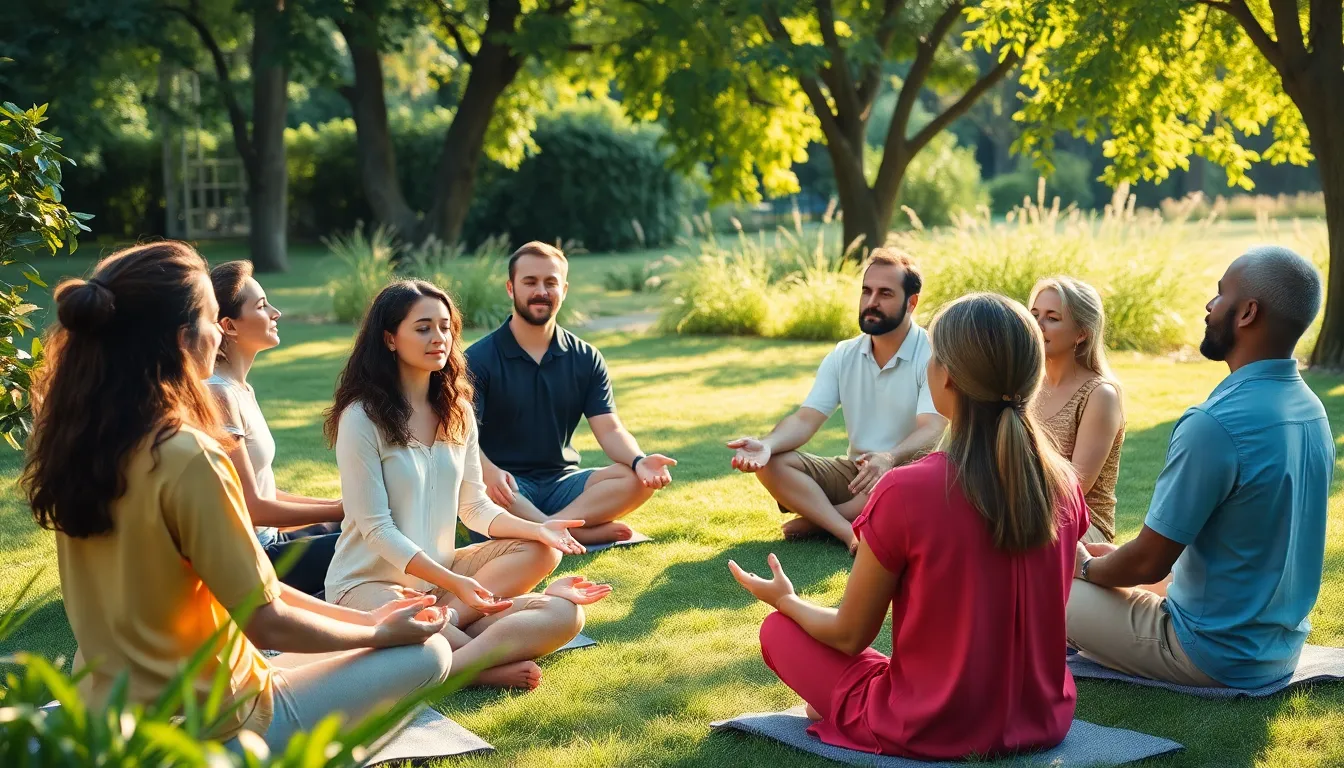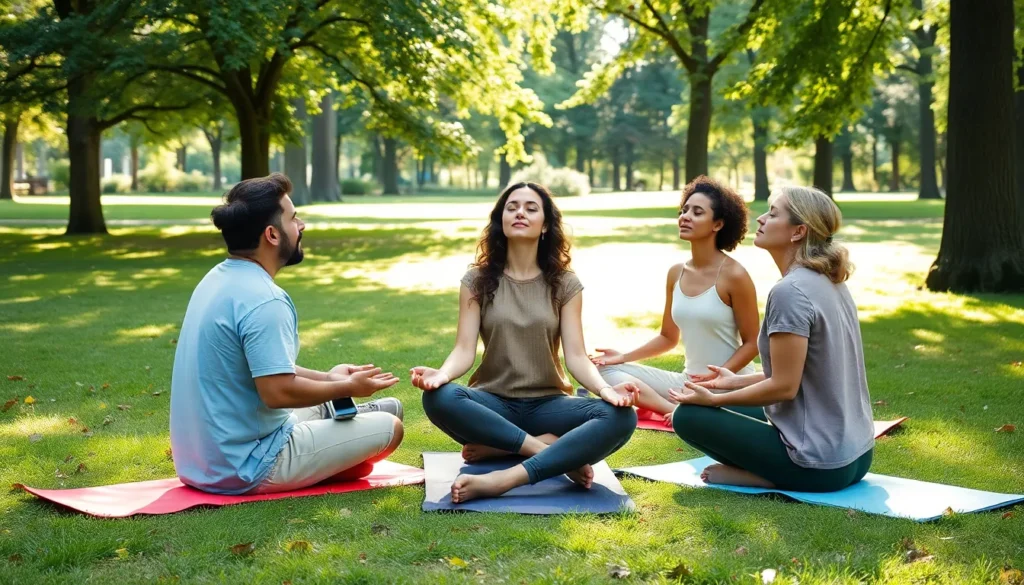Table of Contents
ToggleIn today’s fast-paced world, finding a moment of calm can feel like searching for a needle in a haystack. Enter mindfulness exercises for groups—a delightful way to gather friends, colleagues, or even that one neighbor who always borrows your lawnmower. With the right PDF in hand, turning chaos into serenity has never been easier.
Importance Of Mindfulness In Groups
Mindfulness in groups fosters connection among participants. Enhanced communication leads to a better understanding of one another. Participants often experience reduced stress levels when engaging in these exercises. Trust builds within the group, creating a safe environment for sharing thoughts and feelings.
Additionally, regular mindfulness practice improves emotional regulation. Individuals learn to manage their responses in challenging situations. Collaborative exercises promote a sense of belonging, benefiting both personal and professional relationships. Research indicates that groups practicing mindfulness report higher satisfaction rates and improved teamwork.
Mindfulness enhances focus during discussions and collaborative tasks. Improved concentration allows group members to engage more effectively. Enhanced presence during interactions strengthens connections and boosts creativity. Individuals contribute innovative ideas when feeling relaxed and connected.
Incorporating mindfulness exercises into group settings presents numerous advantages. Participants experience heightened awareness, leading to more meaningful interactions. Emotional intelligence develops as members learn to empathize with each other.
Different mindfulness activities cater to various group dynamics. Groups may choose guided meditations, breathing exercises, or mindful movement to suit their needs. Choosing appropriate exercises encourages active participation, ensuring that each individual benefits.
Utilizing a PDF of mindfulness exercises offers convenience and accessibility. Groups can access resources easily and tailor sessions to specific goals. Establishing regular practice times ensures continuity, allowing the benefits of mindfulness to deepen over time.
Types Of Mindfulness Exercises

Mindfulness exercises promote relaxation and enhance group dynamics. Each exercise comes with unique benefits and can deepen the experience when practiced collectively.
Breathing Exercises
Breathing exercises focus on the breath to anchor attention. Participants can practice deep inhalations and slow exhales, fostering calmness. They encourage mindfulness by heightening awareness of physical sensations. Breathing techniques like box breathing and 4-7-8 breathing are popular choices. Groups often synchronize their breaths, reinforcing connection and unity. Simple instructions guide individuals through each session, making the practice accessible to everyone. Regular use of this exercise can significantly reduce anxiety levels.
Guided Visualizations
Guided visualizations transport participants to calm, peaceful environments. Instructors typically lead these sessions, describing serene scenes that enhance relaxation. Imagery of forests, beaches, or mountains encourages individuals to engage their senses. Mindful listening to a guide allows participants to immerse themselves in tranquility. Groups can share their experiences afterward, strengthening bonds and fostering discussion. Visualization often cultivates a greater sense of self-awareness and reduces stress. Regular practice can enhance creativity and problem-solving abilities within team dynamics.
Group Meditations
Group meditations create collective mindfulness experiences. These sessions often involve sitting in silence or following a facilitator. Participants may focus on their breath or repeating a mantra, promoting mental clarity. Each individual contributes to a peaceful energy in the space, enhancing overall effectiveness. Group sessions encourage participants to support one another, fostering community and trust. Varied techniques can include loving-kindness meditation or body scan meditation. Regular group meditations can significantly increase emotional resilience and interpersonal connections.
Creating A Mindfulness Exercises For Groups PDF
Creating a PDF for mindfulness exercises tailored for groups requires careful consideration of essential elements. Groups benefit most when resources are clear, engaging, and easily accessible.
Essential Components
Inclusion of varied exercises is key. Incorporate sessions like breathing techniques, guided meditations, and visualizations. Each exercise should clearly outline its objectives, duration, and the intended outcomes. Providing step-by-step instructions helps participants feel confident. Adding space for reflections or notes encourages personal insights, enhancing engagement. It’s vital to ensure that the PDF is visually appealing to maintain interest. Proper formatting and headings enable easy navigation, promoting a more effective experience for users.
Design Tips
Design plays a critical role in the effectiveness of the PDF. Use a clean layout that allows for easy reading and comprehension. Consider utilizing bullet points for clarity and quick reference during practice sessions. Employ soothing color schemes that reflect mindfulness, such as blues and greens. Incorporate relevant images or icons that support the exercises and create a calming vibe. Keep fonts legible and size appropriate for all participants. Lastly, including interactive elements, like hyperlinks to audio resources, fosters a richer experience.
Benefits Of Mindfulness Exercises For Groups
Mindfulness exercises benefit groups by reducing stress levels effectively. Participants experience a greater sense of calm, promoting overall mental well-being. Connection among group members strengthens through shared experiences, enhancing communication and trust.
Higher satisfaction rates often emerge in groups that practice mindfulness together. Improved teamwork results from increased focus during discussions, allowing for more effective engagement. Creativity flourishes in environments where mindfulness is part of the routine.
Group exercises, such as guided meditations, foster collective mindfulness experiences. These practices promote emotional resilience and mental clarity, encouraging members to manage responses in challenging situations. Enhanced emotional regulation leads to better personal and professional relationships.
Incorporating mindfulness exercises into regular group activities creates a safe space for sharing. This safety encourages openness and vulnerability, establishing a supportive community among participants. Access to resources, like a PDF of mindfulness exercises, ensures that groups can maintain consistent practice.
Variety in mindfulness activities keeps engagement high. Breathing exercises help participants focus on their breath, calming anxieties, while guided visualizations transport members to serene environments. Such diversity deepens the benefits of mindfulness, making it accessible for different group dynamics.
Regular practice of these exercises leads to sustained benefits, reinforcing the positive changes experienced within the group. Establishing these routines encourages individuals to take ownership of their well-being, ultimately fostering a more harmonious and productive group environment.
Mindfulness exercises for groups offer a powerful way to cultivate calm and connection in an often chaotic world. By engaging in these practices together, participants not only enhance their individual well-being but also strengthen their relationships with one another. The shared experience fosters trust and communication, creating a supportive environment for personal growth.
Utilizing resources like a PDF of mindfulness exercises makes it easier for groups to maintain regular practice. This accessibility ensures that the benefits of mindfulness can be enjoyed consistently. As groups continue to practice together, they’ll likely notice improvements in emotional regulation, teamwork, and overall satisfaction. Embracing mindfulness as a collective journey can lead to lasting positive changes both personally and professionally.




